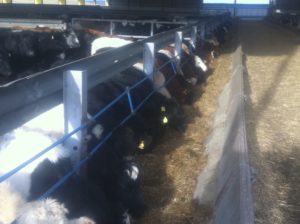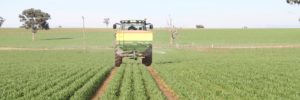Down On the Farm Feb & March 2018
The winter so far has been pretty good to us compared to some other places further south – we seem to have escaped the snow to a great extent, at least so far. We’re not great fans of the white stuff – it’s pretty to look at but it does make pretty much every job on the farm harder to do. It’s easy to forget how much water is actually in the stuff as well – apparently a 4-5” snowfall of the wet type we generally get in the UK is the same as dumping an inch of rain on the land. In other countries they need 10” of their nice powdery snow to have the same effect. How do those lads in the Alps cope when it melts? I recall visiting some friends in Northern Canada as a kid – he farmed maize and basically shup up shop for the entire winter and took another job driving trucks on the ice roads up there until the ground went green again.
Our crops have been pretty dormant for the last few months but have started to show signs of a bit of movement in the last week or so. Nothing is in need of fertilizer yet so we will wait a bit longer before applying anything – it’s always a balance between growth stage of the plants and the right ground temperature and moisture content. If it goes on too early and the ground is too cold, the active ingredients just dissipate without the plants being ready to take them up. Not very efficient and we end up having to apply extra later to make up for it. We also have to be very aware of how soft the land is to avoid causing damage through compaction. Although we do use tramlines in the crops we always try to minimise damage as much as possible. Tramlines are simply rows in the crop where we don’t sow any seed leaving the same obvious track that is used every time we need to do work with the crop. This way we keep compaction to a very small area of the field and we can then run a subsoiling plough through these areas after harvest to break the ground up again.
We have spent some time getting some of the cattle sheds mucked out and the manure stacked on hard pads ready for applying later in the year. The ground has been too wet to actually get it spread on the fields – we need a few good days of heavy frost to allow the big trailers to travel without sinking in. The manure composts down better when it is stacked – the natural heat build up in a muck heap is surprisingly high and helps break down the organic matter as well as killing weed seeds which might get carried onto the fields later. A decent stack should get crier and more crumby as time goes on,
All the cattle are still indoors so it’s very much the normal feeding and bedding routine for Wade and Maurice, our farm staff. In between they try to do any fencing, mend gates, service machinery etc while things are quiet. The sheds are reasonable full just now although we have been regularly selling finished cattle since the start of the year. Victoria’s Dad is away visiting family in New Zealand so we will wait until he gets back before any more store cattle are bought to fill things up again. Store cattle by the way are young small ones that we buy in from local farms which we then graze and feed over the subsequent year or more until they are the right weight and condition for slaughter . Don’t worry though – we still have plenty for the farm shop – in fact, only a small percentage of our beef cattle are selected for the shop, the rest go to other butchers and general food trade. That means that we can choose the very best for ourselves – lighter animals with just the right amount of condition so that we can hang them well for taste and texture.

The ewes are in decent shape and are getting a bit of extra feed as pregnancy progresses. It’s a pretty basic mix of rolled barley with some vitamins and minerals which we make ourselves. If the grass gets particularly short then we will also provide silage to make sure they have enough forage. Being ruminants, it’s important to keep sheep and cattle with full stomachs. The mixed diet makes sure they have the enough energy to keep the lambs growing well but without the ewe getting over fat. Often, ewes in too good a condition are more prone to lambing problems so we try to avoid it. The opposite is also true – too thin and the lambs are not as strong plus the ewes milk quality and output is reduced.
The pigs are probably the least bothersome enterprise we have on the farm – as long as they are well fed and watered and have plenty of straw to bed down in they are happy. Generally the only problem we get is with frozen pipes and drinkers – fortunately this year we haven’t had too much frost to cause problems inside the buildings. It’s never much fun trying to thaw yards of piping while the pigs chew your wellies as they wait for the water to come through. It’s even more annoying when the tractor driver pops in from his nice heated cab to tell you how wonderful it has to have the heavy frost and now he can get on spreading his muck (see earlier paragraph)

